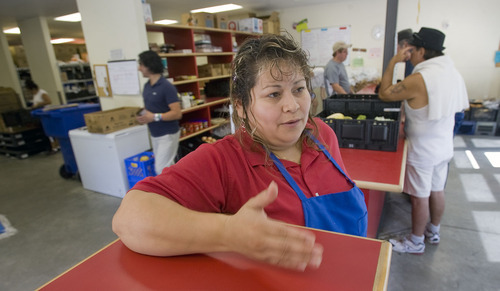This is an archived article that was published on sltrib.com in 2011, and information in the article may be outdated. It is provided only for personal research purposes and may not be reprinted.
The recession officially ended more than two years ago but that's not reflected in new U.S. Census numbers released Tuesday showing 46.2 million people are now living in poverty — the largest number since the census began tracking poverty in 1959.
The Census Bureau's annual report, based on estimates, shows that in 2010 median household income declined and the poverty rate increased for the third consecutive year. The census estimated 10 percent of Utahns, or 283,000 people, lived in poverty in 2010 — up from 9.7 percent in 2009.
Based on what's happening with Utah's food stamp case load and at Hildegarde's Food Pantry in Salt Lake City, the economic well-being of families has continued to worsen since last year.
For the past two months, the number of people served at the pantry has been climbing and Lydia Herrera is seeing more families who can't make ends meet despite having at least one parent working.
"They say their hours have got cut," said Herrera, pantry director. "Even if you have a job, you can't make it through the month and you need help feeding your children."
Until three weeks ago, the pantry typically served 157 to 180 people during a three-hour span Tuesday through Friday. It now is consistently topping 200 people — and served a record 287 people on its highest day. Donations are down, too, and some Fridays the pantry's shelves are emptied.
"It is really hard times for everybody," said Herrera, who has worked at the pantry, sponsored by St. Mark's Cathedral, for 10 years.
Nationally, the median household income fell 2.3 percent to $49,445. Most state data won't be released until Sept. 22, but census officials said the largest percentage change in real median income, adjusted for inflation, occurred in the West, which includes Utah.
In the West, median household income was $53,142, down 2.9 percent from 2009. Median household income in Utah was $56,787, down from $59,457 in 2009. The decline was particularly marked in two age groups: those 15 to 24, whose income decline 9.3 percent, and those 45 to 54, whose household income declined 4.3 percent.
"In real terms, this means more families and individuals living at income levels where basic needs like housing, food and transportation costs continue to be an extreme burden, if not completely out of reach," said Drew Martinez, policy analyst for Community Action Partnership of Utah.
The census said the nation's overall poverty rate was 15.1 percent, up from 14.3 percent, or 43.6 million people, in 2009. For a family of four, the national average poverty threshold in 2010 was $22,314. Of concern to advocates, more children under the age of 18 are now living in poverty — 22 percent in 2010, up from 20.7 percent in 2009.
The report states that without Social Security income, 20 million more people nationwide would slip below the poverty threshold; of that number, nearly 14 percent would be adults 65 and older.
Another measure: Since 2007, the number of men working full time, year-round with earnings decreased by 6.6 million and the number of women declined by 2.8 million. The national unemployment rate continues to hover around 9 percent, while Utah's unemployment rate is currently 7.5 percent.
And many more people are relying on government-sponsored health insurance programs or going without coverage — a category that includes some 50 million people, the census said.
The report comes at a politically sensitive time for President Barack Obama, who has acknowledged in the midst of a re-election fight that the unemployment rate could persist at high levels through next year.
Bruce Meyer, a public policy professor at the University of Chicago, told The Associated Press the worst may be yet to come as far as poverty levels, citing in part continued rising demand for food stamps as well as "staggeringly high" numbers in those unemployed for more than 26 weeks. Nationally, 45 million people received food stamp benefits in June 2011, up from 41 million people in June 2010, according to separate data from the U.S. Department of Agriculture.
That data shows in Utah, on average one in eight households struggled with hunger during the years 2008-2010. The most recent data from the Utah Department of Workforce Services shows food stamp cases increased every month last year and there has been no slowdown in 2011. Preliminary numbers show the food stamp case load in Utah reached a high of 112,669 in August.
"We continue to see evidence of the struggles facing too many people in our state. Congress must support job creation while protecting the federal nutrition programs and other parts of our nation's safety net against deficit cutting measures," said Gina Cornia, executive director of Utahns Against Hunger. "Weakening these programs would cause irreparable harm to low-income people in Utah and across the nation."
The Associated Press contributed to this report.







